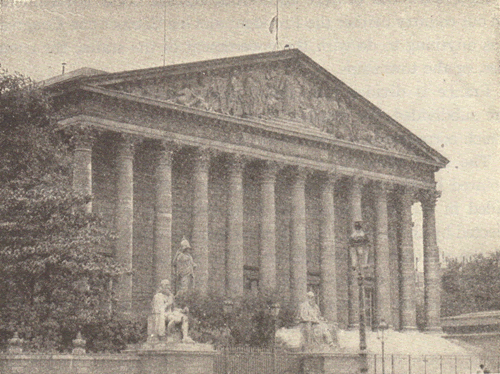| Chamber of Deputies, Paris |
|---|
| studenthandouts.com ↣ World Geography ↣ Europe ↣ Western Europe ↣ France |
 Chamber of Deputies, Paris, France. The original building, begun in 1722, was a palace. It was enlarged at various times and declared national property during the French Revolution. The side facing the river, shown here, was built in 1804 to 1807, in the style of a Greek temple. [Photo and caption circa 1920.] Click here to enlarge.
Chamber of Deputies, Paris, France. The original building, begun in 1722, was a palace. It was enlarged at various times and declared national property during the French Revolution. The side facing the river, shown here, was built in 1804 to 1807, in the style of a Greek temple. [Photo and caption circa 1920.] Click here to enlarge.
The Chamber of Deputies, historically one of the legislative bodies in France, played a crucial role in the country's political landscape, particularly during the 19th and early 20th centuries. Located in the Palais Bourbon on the left bank of the Seine River in Paris, the Chamber of Deputies was the lower house of the French Parliament under various regimes, including the July Monarchy, the Second Republic, the Second Empire, and the Third Republic. The Palais Bourbon itself is an architectural masterpiece, originally constructed in the early 18th century for Louise Françoise de Bourbon, the Duchess of Bourbon. It was transformed into a legislative building during the French Revolution, and its neoclassical façade and grand interiors reflect the grandeur and significance of its function. The Chamber of Deputies was established as part of the bicameral legislative system, with its members elected by direct suffrage. This body was instrumental in shaping French law and policy, often reflecting the political shifts and social changes within the country. During the July Monarchy (1830-1848), for instance, the Chamber of Deputies was a hotbed of political debate, balancing the interests of the bourgeoisie with the demands for more democratic reforms. In the Third Republic (1870-1940), the Chamber of Deputies gained significant power, reflecting the period's democratic ideals. It was responsible for proposing and voting on laws, and it played a key role in the governance of the country, often in conflict or collaboration with the Senate and the executive branch. The deputies were elected for a four-year term, and their debates and decisions had a profound impact on French society, economy, and foreign policy. The Chamber of Deputies witnessed numerous historical events, such as the contentious debates during the Dreyfus Affair, which highlighted issues of anti-Semitism and injustice, and the discussions leading up to and following World War I, which shaped France's interwar policies. In 1958, with the establishment of the Fifth Republic by Charles de Gaulle, the Chamber of Deputies was replaced by the National Assembly, which retained its legislative functions but operated under a new constitution designed to stabilize French governance and prevent the political instability that had plagued previous regimes. Today, the National Assembly continues the legacy of the Chamber of Deputies, serving as a vital institution in French democracy, housed in the historic Palais Bourbon, and reflecting the enduring principles of republicanism and representative government. |
 |  |  |  |  |  |
| studenthandouts.com ↣ World Geography ↣ Europe ↣ Western Europe ↣ France |








